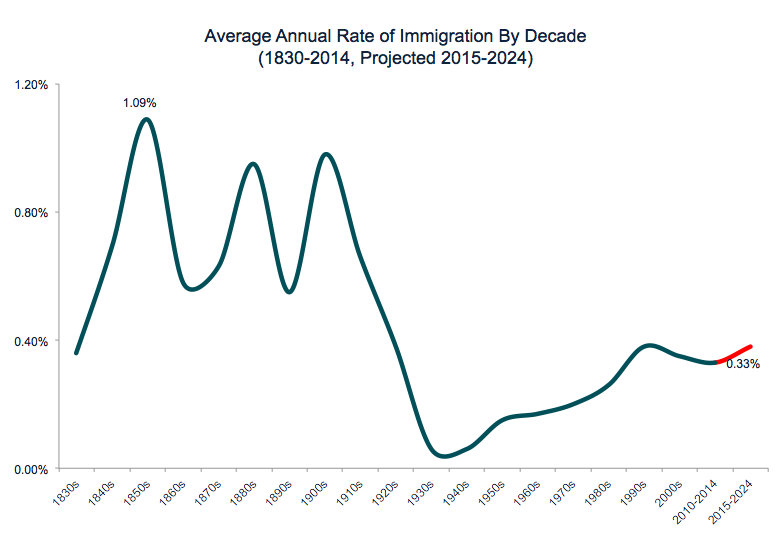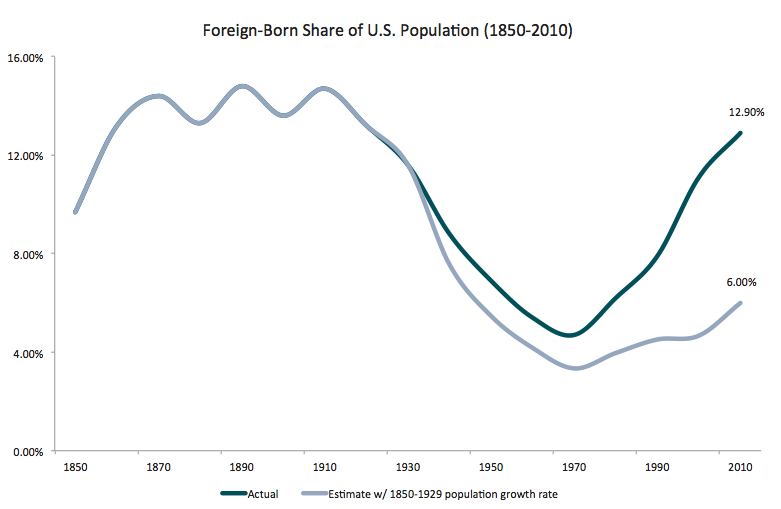Central to recent criticisms of immigration is the idea that America is undergoing a historic wave of immigration. “The Census Bureau estimates that another 14 million immigrants will come to the United States between now and 2025,” Senator Jeff Sessions (R-AL) recently wrote in The Washington Post. “It is not mainstream, but extreme, to continue surging immigration beyond any historical precedent.”[i]
But Sen. Sessions misinterprets the data. Not only is immigration not “beyond any historical precedent,” it is far below its historic peak in the 20th century. The best way to measure the level of immigration is not with the absolute number admitted, but with the number relative to the population of the country. It would be misleading to say, for example, that because America received five times the number of immigrants that Canada did in recent years, it has five times Canada’s level of immigration since America is a much larger country. Controlling for its population, the rate of immigration to Canada is currently about twice the rate of immigration to the United States.[ii]
In the same way, any fair comparison of America today with America’s past would control for the size of the country. The Census Bureau estimate cited by Sen. Sessions concluded that over the next decade, immigration to the United States will annually average 0.38 percent of the U.S. population.[iii] As evident in Chart 1, this level is not beyond any historical precedent. In fact, immigration was this level or higher for an entire century from the 1830s to the 1920s.[iv]
During this period, annual immigration averaged 0.64 percent of the population, fully twice the rate of immigration in the current decade. During the peak decade from 1850 to 1859, immigration reached 1.1 percent of the population, more than three times the current level. During the peak year in 1854, immigration topped out at 1.59 percent of the population, nearly five times the rate in 2014. By no measure is immigration today unprecedented. In fact, the level of immigration in 2014 was 50 percent below the historical average.
It is true that the foreign-born population in the United States has grown to its highest level as a share of the overall population since the early 20th century, but this is not due to an increase in immigration, but to a decrease in population growth, because of a drop in the native birthrate. The foreign-born population reached 12.9 percent in 2010 compared to 14.7 percent in 1910. But if the U.S. population had grown at the same rate from 1930 to 2010 that it grew from 1850 to 1929, the foreign-born share of the population would have been just 6 percent in 2010.[v] Chart 2 compares the actual foreign-born share of the population compared to its share if the birth rate had not declined.
The stock of immigrants as a percentage of the population is more than twice as high as it would be if the general population had grown as fast as it did before 1930. In other words, the reason for the greater percentage of immigrants in the United States today is not due to a huge influx of immigrants entering the country, but to fewer Americans entering the world. The immigration “flood” is fiction.
Read the full study here.
CITATIONS
[i] Sessions, Jeff. “America Needs to Curb Immigration Flows.” The Washington Post, April 10, 2015. Accessed May 6, 2015. http://www.washingtonpost.com/opinions/slow-the-immigration-wave/2015/04/09/c6d8e3d4-dd52-11e4-a500-1c5bb1d8ff6a_story.html
[ii] Statistics Canada, “Immigrants admitted and number planned by category according to the immigration plan, Canada, 2009 to 2012,” July 9, 2013. Accessed May 6, 2015. http://www.statcan.gc.ca/pub/91-209-x/2013001/article/11787/tbl/tbl1-eng.htm
[iii] Census Bureau, “Table 1. Projections of the Population and Components of Change for the United States: 2015 to 2060.” Accessed May 6, 2015. http://www.census.gov/population/projections/data/national/2014/summarytables.html
[iv] Department of Homeland Security, “U.S. Lawful Permanent Residents: 2013.” Accessed May 4, 2015. http://www.dhs.gov/publication/us-lawful-permanent-residents-2013
[v] U.S. Department of Commerce. “Historical Statistics of the United States: Colonial Times to 1970: Part 1.” 1975. Accessed May 4, 2015. https://ia700407.us.archive.org/4/items/HistoricalStatisticsOfTheUnitedStatesColonialTimesTo1970/us_historical_statistics_colonial_times_to_1970.pdf
Census Bureau. “Pre-1980: National Tables.” Accessed May 4, 2015.
https://www.census.gov/popest/data/historical/pre-1980/index.html

